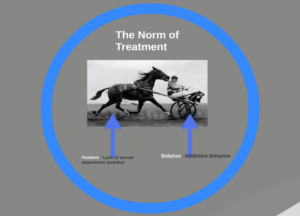
[ad_1]
 “what am I lacking; I hold relapsing and don’t know why I’ve such a tough time remaining clear and sober?”
“what am I lacking; I hold relapsing and don’t know why I’ve such a tough time remaining clear and sober?”
How we deal with habit in remedy should change. The concept we will present info and train a person methods to stay clear and sober is a fallacy. Most addicts and alcoholics are above common in intelligence and the query is “Don’t you assume in the event that they could possibly be taught methods to cease destroying their life they might merely learn a guide and the issue can be eradicated?” The reply is “Of Course.” Who would select to drink, drug, or addictively act out realizing their life is over in the event that they do?” No one. Thus, individuals know they usually nonetheless partake in these behaviors.
Due to this fact, the reply isn’t merely schooling.
Info:
- 9% of the U.S. inhabitants meets the factors for substance use dysfunction (SUDs) (Substance Abuse and Psychological Well being Companies Administration 2010);
- Drug-related suicide makes an attempt elevated by 41% from 2004-2011 (Drug Abuse Warning Community (DAWN);
- Therapeutic alliance is among the biggest predictors of optimistic remedy outcomes (Straussner, 2012).
“Till an addict or alcoholic develops the capability to determine mutually satisfying relationships, they are going to stay susceptible to relapse and the continuous substitution of 1 habit for one more (Phillip Flores)
What’s Attachment Concept?
“Many of the psychopathology seen within the alcoholic is the end result, not the reason for alcohol abuse.” (Valiant, 1983).
If we don’t start treating the issue, which fairly presumably stems from an absence of safe attachment modeled throughout childhood, versus the answer, addictive habits, we will depend on continued remedy failure, typically known as resistance to remedy. Resistance to remedy appears to be a means of claiming it’s the affected person’s fault not ours. Due to this fact, we put the cart earlier than the horse.

The results of placing the cart earlier than the horse is the next:
- We admit a affected person to remedy with distorted definitions of ideas discovered as a toddler, i.e., honesty, hope, religion, braveness, integrity, willingness, humility, concord, self-discipline, perseverance, consciousness, service
- The affected person discovered these definitions from their caregiver or mum or dad from the fashions introduced to them as kids.
- How would the affected person know these definitions are probably dysfunctional if it’s all they know?
- How efficient will step work be if the affected person doesn’t have a mannequin or wholesome definition of what the rules of the steps espouse?
Attachment concept assumes that the expertise of childhood relationships shapes grownup attachment types. These experiences create the highway map or inside working mannequin for the way the person will understand himself and others relationally (Bowlby, 1973).
The essential premise is that we solely know what we all know. For instance, two males are sitting within the park discussing zoo animals. The one man asks the opposite if he has ever seen an elephant, to which the opposite man replies ‘no, what does it seem like?’ The person states, ‘it’s a giant gray animal that has 4 hoofs, tough pores and skin, floppy ears and trunk within the entrance’. The opposite man states ‘you imply just like the tree trunk outdoors?’ The person replies ‘no, not a tree trunk’. To which many asks ‘You imply just like the trunk of my automotive?’ The purpose is that the person will solely know what an elephant appears like if he sees an image or goes to the zoo. Equally, if a toddler grows up with caregivers who’re bodily current though not emotionally current, thus, missing a practical definition of emotional availability and intimacy, the kid is extra prone to have a stunted view of being emotionally current for others of their life. It is rather potential that when this little one turns into an grownup, their innate want for safe attachment won’t be met except they see a mannequin of what wholesome attachment appears like.
The essential precept of Attachment Concept is that these with safe attachment (stronger emotional relationship with caregiver) are higher in a position to regulate feelings and have fewer relationship issues. Nonetheless, disruptions within the attachment system (insecure attachment) can result in vulnerabilities within the sense of self and others in addition to relationship issues; thus, resulting in disgrace, co-dependency, and a must numb ache through addictive habits. Due to this fact, if we don’t deal with and mannequin safe attachments to sufferers, they are going to keep caught within the resolution of repeatedly searching for to keep away from and discharge ache by addictiveness.
Analysis means that relationships affect mind growth and “relationships have the capability to rebuild sure components of the mind that affect social and emotional lives; clinicians can assist shoppers to change their attachment patterns with a safe medical relationship. (Miehls, 2011, p. 82).
The underside line in defining Attachment Concept is that the aim of remedy must be centered on altering the definition and mannequin of what it means to really feel included, cherished, and safe. “The shortcoming to determine wholesome relationships is a significant contributing issue to relapses and the return to substance use.” (Flores, 2004). Thus, the reply to “sh*t what am I lacking?” is: Not having had a transparent mannequin of safe attachment as a result of it was partially or fully missed throughout childhood. As Flores said:
“Therapists should have the ability to problem, soothe, care, love, and if needed, combat with a affected person if they can present a full vary of emotional experiences that may probably come alive in an genuine relationship. (Flores, 2004, p. 259).
To sum up half considered one of this text, except we offer a strong definition of ideas that we see as regular (primarily based on definitions that have been modeled) albeit dysfunctional and damaging, the way in which we work the 12 steps can be flawed and primarily based on dysfunctional definitions, missing a lot change in habits. Alternatively, we will make the most of the 12 steps as a corrective expertise by deciphering every step as follows:
Decoding the 12 Steps from an attachment perspective:
Step 1: The expertise of abandonment;
Step 2: Permission to hope; integration to others;
Step 3: Taking a danger (vulnerability) to connect
Step 4: Taking a danger to attune with self
Step 5: Taking a danger to connect to a different individual
Step 6-7: Correcting and repairing relationship with self
Step 8-9: Correcting and repairing relationships with others
Step 10: Private accountability for securely hooked up relationships in my life
Step 11: Solidifying a safe attachment to my Greater Energy
Step 12: Rising my capacity to mannequin securely hooked up relationships to others
The previous article was solely written by the creator named above. Any views and opinions expressed should not essentially shared by GoodTherapy.org. Questions or considerations in regards to the previous article will be directed to the creator or posted as a remark beneath.
[ad_2]
